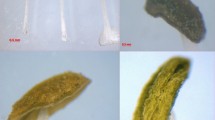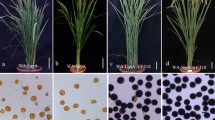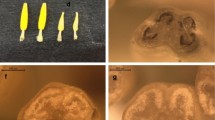Abstract
Single dominant fertility restoration (Rf) genes for cytoplasmic male-sterile (CMS) sunflower lines CMS ANN2 and CMS ANN3 were previously identified in three and five sources, respectively. However, expressions of the dominant Rf genes were suppressed when crossing restoration lines with three inbred lines. Preliminary results indicated that segregation of fertility in most testcross progeny families from crosses of half-diallel F1’s of restoration lines with the two CMS lines, respectively, did not agree with those of the F2 generation of the half-diallel crosses. In this study, using selected CMS ANN2 and CMS ANN3 plants without the silencing suppressor (S) genes, we confirmed the existence of S genes in the nuclear genomes of the CMS lines used for crossing of the two CMS cytoplasms. Inheritance study suggested that Rf gene suppression was controlled by a single dominant gene in specific backgrounds, whereas two to three complementary S genes could exist in certain backgrounds. Using testcross population Rf ANN2-P21/RHA 274//Rf ANN2-P21, a single S gene from RHA 274, designated S1, was mapped to a recombination suppressed region on the sunflower linkage group (LG) 3, co-segregating with 16 SSR or single nucleotide polymorphism (SNP) markers, flanked by NSA_003339 and ORS124 at a distance of 1.4 and 0.7 cM, respectively. These molecular markers will potentially assist in identifying lines without suppressor genes, including CMS lines.
Key message
Unique suppression of Rf genes confirmed existence of suppressor (S1) gene in CMS lines that mapped to a recombination suppressed region on linkage group 3, which will enhance understanding of cytoplasm-nuclear interactions.

Similar content being viewed by others
References
Bowers JE, Bachlava E, Brunick RL, Rieseberg LH, Knapp SJ, Burke JM (2012) Development of a 10,000 locus genetic map of the sunflower genome based on multiple crosses. G3: Genes Genomes Genet 2:721–729
Burke JM, Lai Z, Salmaso M, Nakazato T, Tang S, Heesacker A, Knapp SJ, Rieseberg LH (2004) Comparative mapping and rapid karyotypic evolution in the genus Helianthus. Genetics 167:449–457
Burke JM, Tang S, Knapp SJ, Rieseberg LH (2002) Genetic analysis of sunflower domestication. Genetics 161:1257–1267
Chandler JM, Jan CC, Beard BH (1986) Chromosomal differentiation among the annual Helianthus species. Syst Bot 11:354–371
Chen L, Liu YG (2014) Male sterility and fertility restoration in crops. Annu Rev Plant Biol 65:579–606
Dahan J, Mireau H (2013) The Rf and Rf-like PPR in higher plants, a fast-evolving subclass of PPR genes. RNA Biol 10:1469–1476
Delannoy E, Stanley WA, Bond CS, Small ID (2007) Pentatricopeptide repeat (PPR) proteins as sequence-specificity factors in post-transcriptional processes in organelles. Biochem Soc Trans 35:1643–1647
Eckardt NA (2006) Cytoplasmic male sterility and fertility restoration. Plant Cell 18:515–517
Feng J, Liu Z, Cai XW, Jan CC (2013) Toward a molecular cytogenetic map for cultivated sunflower (Helianthus annuus L.) by landed BAC/BIBAC clones. G3: Genes Genomes Genet 3:31–40
Fick GN, Kinmana ML, Zimmer DE (1975) Registration of ‘RHA 273’ and ‘RHA 274’ sunflower parental lines. Crop Sci 15:106
Fishman L, Stathos A, Beardsley PM, Williams CF, Hill JP (2013) Chromosomal rearrangements and the genetics of reproductive barriers in mimulus (monkey flowers). Evolution 67:2547–2560
Fujii S, Toriyama K (2009) ressed expression of RETROGRADE-REGULATED MALE STERILITY restores pollen fertility in cytoplasmic male sterile rice plants. Proc Natl Acad Sci U S A 106:9513–9518
Heiser CB Jr (1954) Variation and subspeciation in the common sunflower, Helianthus annuus. Am Midl Nat 51:287–305
Horn R, Kusterer B, Lazarescu E, Prüfe M, Friedt W (2003) Molecular mapping of the Rf1 gene restoring pollen fertility in PET1-based F1 hybrids in sunflower (Helianthus annuus L.). Theor Appl Genet 106:599–606
Hu YM, Tang JH, Yang H, Xie HL, Lu XM, Niu JH, Chen WC (2006) Identification and mapping of Rf-I an inhibitor of the Rf5 restorer gene for Cms-C in maize (Zea mays L.). Theor Appl Genet 113:357–360
Hulke BS, Grassa CJ, Bowers JE, Burke JM, Qi L, Talukder ZI, Rieseberg LH (2015) A unified single nucleotide polymorphism map of sunflower (Helianthus annuus L.) derived from current genomic resources. Crop Sci 55:1696–1702
Jan CC (2000) Cytoplasmic male sterility in two wild Helianthus annuus L. accessions and their fertility restoration. Crop Sci 40:1535–1538
Jan CC (2003) Silence of fertility restoration genes in sunflower. Helia 26(39):1–6
Jan CC (2006) Registration of two cytoplasmic male-sterile and eight fertility restoration sunflower genetic stocks. Crop Sci 46:1835–1836
Jan CC, Miller JF, Seiler GJ, Fick GN (2006) Registration of one cytoplasmic male-sterile and two fertility restoration sunflower genetic stocks. Crop Sci 46:1835
Jan CC, Zhang TX, Miller JF, Fick GN (2002) Inheritance of fertility restoration for two cytoplasmic male sterility sources of Helianthus pauciflorus (rigidus) Nutt. Crop Sci 42:1873–1875
Koenig D, Jiménez-Gómez JM, Kimura S, Fulop D, Chitwood DH, Headland LR, Kumar R, Covington MF, Devisetty UK, Tat AV, Tohge T, Bolger A, Schneeberger K, Ossowski S, Lanz C, Xiong G, Taylor-Teeples M, Brady SM, Pauly M, Weigel D, Usadel B, Fernie AR, Peng J, Sinha NR, Maloof JN (2013) Comparative transcriptomics reveals patterns of selection in domesticated and wild tomato. Proc Natl Acad Sci U S A 110:E2655–E2662
Kosambi DD (1944) The estimation of map distances from recombination values. Ann Eugenics 12:172–175
Lander ES, Green P, Abrahamson J, Barlow A, Daly MJ, Stephen EL, Newburg L (1987) MAPMAKER: an interactive computer package for constructing primary genetic linkage maps of experimental and natural populations. Genomics 1:174–181
Leclercq P (1969) Une stérilité male cytoplasmic chez le tournesol. Ann Amélior Plant 19:99–106
Li SF, Iacuone S, Parish RW (2007) Suppression and restoration of male fertility using a transcription factor. Plant Biotechnol J 5:297–312
Liu Z, Wang D, Feng J, Seiler GJ, Cai X, Jan CC (2013) Diversifying sunflower germplasm by integration and mapping of a novel male fertility restoration gene. Genetics 193:727–737
Liu Z, Mulpuri S, Feng J, Vick BA, Jan CC (2012) Molecular mapping of the Rf 3 fertility restoration gene to facilitate its utilization in breeding confection sunflower. Mol Breed 29:275–284
Long YM, Chao WS, Ma GJ, Xu SS, Qi LL (2017) An innovative SNP genotyping method adapting to multiple platforms and throughputs. Theor Appl Genet 130:597–607
Ma Y, Min L, Wang M, Wang C, Zhao Y, Li Y, Fang Q, Wu Y, Xie S, Ding Y, Su X, Hu Q, Zhang Q, Li X, Zhang X (2018) Disrupted genome methylation in response to high temperature has distinct affects on microspore abortion and anther indehiscence. Plant Cell 30:1387–1403. https://doi.org/10.1105/tpc.18.00074
Michelmore RW, Paran I, Kesseli RV (1991) Identification of markers linked to disease resistance genes by bulked segregant analysis: a rapid method to detect markers in specific genomic regions by using segregating populations. Proc Natl Acad Sci U S A 88:9828–9832
Miller JF, Fick GN (1997) The genetics of sunflower. In: Schneiter AA (ed) Sunflower technology and production. Madison, Wisconsin, pp 441–495
Ostberg CO, Hauser L, Pritchard VL, Garza JC, Naish KA (2013) Chromosome rearrangements, recombination suppression, and limited segregation distortion in hybrids between Yellowstone cutthroat trout (Oncorhynchus clarkii bouvieri) and rainbow trout (O. mykiss). BMC Genomics 14:570
Qi LL, Foley ME, Cai XW, Gulya TJ (2016) Genetics and mapping of a novel downy mildew resistance gene, Pl 18, introgressed from wild Helianthus argophyllus into cultivated sunflower (Helianthus annuus L.). Theor Appl Genet 129:741–752
Qi LL, Long YM, Jan CC, Ma GJ, Gulya TJ (2015) Pl 17 is a novel gene independent of known downy mildew resistance genes in the cultivated sunflower (Helianthus annuus L.). Theor Appl Genet 128:757–767
Qi LL, Seiler GJ, Vick BA, Gulya TJ (2012) Genetics and mapping of the R 11 gene conferring resistance to recently emerged rust races, tightly linked to male fertility restoration, in sunflower (Helianthus annuus L.). Theor Appl Genet 125:921–932
Seiler GJ, Qi LL, Marek LF (2017) Utilization of sunflower crop wild relatives for cultivated sunflower improvement. Crop Sci 57:1–19
Serieys H (1996) Identification, study and utilization in breeding programs of new CMS sources. FAO progress report. Helia 19(special issue):144–158
Serieys H (2005) Identification, study and utilization in breeding programs of new CMS sources, in the FAO Subnetwork, in Proc. 2005 Sunflower Subnetwork Progress Report, FAO, Rome, Italy, pp 47–53
Sinha R, Rajam MV (2013) RNAi silencing of three homologues of S-adenosylmethionine decarboxylase gene in tapetal tissue of tomato results in male sterility. Plant Mol Biol 82:169–180
Talukder ZI, Gong L, Hulke BS, Pegadaraju V, Song Q, Schultz Q, Qi L (2014) A high-density SNP map of sunflower derived from RAD-sequencing facilitating fine-mapping of the rust resistance gene R 12. PLoS One 9:e98628
Touzet P, Budar F (2004) Unveiling the molecular arms race between two conflicting genomes in cytoplasmic male sterility? Trends Plant Sci 9:568–570
Toppino L, Kooiker M, Lindner M, Dreni L, Rotino GL, Kater MM (2011) Reversible male sterility in eggplant (Solanum melongena L.) by artificial microRNA-mediated silencing of general transcription factor genes. Plant Biotechnol J 9:684–692
Voorrips RE (2002) MapChart: software for the graphical presentation of linkage maps and QTLs. J Heredity 93:77–78
Wang Z, Zou Y, Li X, Zhang Q, Chen L, Wu H, Su D, Chen Y, Gu J, Luo D, Long Y (2006) Cytoplasmic male sterility of rice with boro II cytoplasm is caused by a cytotoxic peptide and is restored by two related PPR motif genes via distinct modes of mRNA silencing. Plant Cell 18:676–687
Acknowledgments
The authors are very grateful to Lisa Brown for technical assistance in this study. We thank Ms. Puying Zheng and Drs. Hongxia Wang and Wei Zhou for their help in the fertility evaluation and molecular marker screening. We appreciate Drs. Lili Qi and Zahirul Talukder for their valuable discussions during the study. We also thank Drs. Larry G. Campbell and Lili Qi for critical review of the manuscript.
Funding
The project was supported by the USDA-ARS National Sclerotinia Initiative, grant number 3060-21220-028-00D, and the USDA-ARS CRIS Project No. 3060-21000-039-00D. Mention of trade names or commercial products in this article is solely for the purpose of providing specific information and does not imply recommendation or endorsement by the U.S. Department of Agriculture. The USDA is an equal opportunity provider and employer.
Author information
Authors and Affiliations
Contributions
Conceived and designed the experiments: CCJ, ZL. Performed the experiments: ZL, CCJ, YL, SSX. Analyzed the data; ZL, CCJ, YL, SSX. Wrote the paper: ZL, CCJ, GJS, YL. Commented on the manuscript before submission: ZL, CCJ, YL, SSX, GJS.
Corresponding author
Ethics declarations
Conflict of interest
The authors declare that they have no conflict of interest.
Ethical statement
The experiments were performed in compliance with the current laws of the USA.
Additional information
Publisher’s note
Springer Nature remains neutral with regard to jurisdictional claims in published maps and institutional affiliations.
Electronic supplementary material
ESM 1
(DOCX 16 kb)
Supplementary Fig. 1
Illustration of the development of the backcross mapping population derived from Rf ANN2-P21/RHA 274//Rf ANN2-P21, with one suppressor gene S1 controlling male fertility in the F1 hybrid. A homozygous MF female parent Rf ANN2-P21 (RfRfs1s1) with cytoplasm of CMS ANN2 was pollinated by RHA 274 (rfrfS1S1), resulting in the MS F1 (RfrfS1s1). The F1 was backcrossed with the pollen of homozygous MF female parent (RfRfs1s1), thus the ratio of MS:MF progeny in the BC1 generation was 1:1. Supplementary Fig. 2 Representative image of nine co-dominant semi-thermal asymmetric reverse PCR (STARP)-based SNP markers among parents and F1 plants of the cross Rf ANN2-P21/RHA 274 on a denaturing polyacrylamide gel. (Lanes 1 and 2) Female parent Rf ANN2-P21; (3 and 4) F1; (5 and 6) Male parent RHA 274; (7 and 8) Two homozygous male-fertile BC1 plants derived from Rf ANN2-P21/RHA 274//Rf ANN2-P21. (PPTX 442 kb)
Rights and permissions
About this article
Cite this article
Liu, Z., Long, Y., Xu, S.S. et al. Unique fertility restoration suppressor genes for male-sterile CMS ANN2 and CMS ANN3 cytoplasms in sunflower (Helianthus annuus L.). Mol Breeding 39, 22 (2019). https://doi.org/10.1007/s11032-018-0922-y
Received:
Accepted:
Published:
DOI: https://doi.org/10.1007/s11032-018-0922-y




